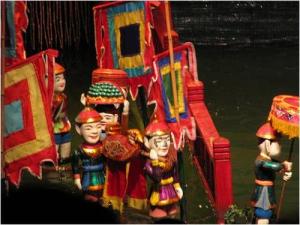Water Puppets: A Showcase of Vietnam’s Creativity

An unique and spectacular form of art, as fascinating as the country it roots from, Vietnam’s Water Puppetry had charmed people even from centuries ago and though feared to be forgotten for a while, is now re-lived, reaching out to greater audiences and captivating the souls and imagination of people from different parts of the world.
History talks of how the Red River spills its waters across the region in certain times of the year have stirred the creativity of the peasants, known as the creators of this performing art, thus brought about the birth of this unique form of entertainment. Though the exact time as to when water puppetry began in the country is not fully known, the Doi Pagoda (in Duy Tien district of Nam Ha province) holds the Sung Tung Thien Linh stele dated back to the 11th century bears inscriptions demonstrating water puppet performances staged to honor and amuse King Ly Nhan Tong, who then ruled during the Ly Dynasty.
Creating the handmade puppets alone is an art in itself with the exemplary sculpt work and lacquer work unveiled in every figure. Made of carefully chosen wood that is light enough to float in the water, yet durable to last long periods and prevent pests, each coated piece assumes a unique appearance and character. Performing in waist-deep waters, puppeteers cleverly manipulate the puppet figures behind a screen. The movements of the puppets are controlled by a system of strings and bamboo poles. Traditionally, a floating communal house made of painted wood serves a stage for puppet performances, of which, every show is accompanied by musical instruments such as gongs and cymbals echoing along with coordinating firecracker sounds. Murky water better conceals the manipulating devices, but at the same time, is always part of the show itself. The beautiful combination of visual effects, sounds, fire, movements of the marionettes is a splendid display of true creativity.
Puppet performances feature folk tales and skits that demonstrate the daily life in rural villages, childhood days, harvest, fishing, festivities, heroic legends and the traditional fondness for learning - all grasping the interest and fancy of both children and adult audiences while at the same time giving them a glimpse of the diversity of Vietnam’s culture and customs.
During the centralization period, puppet performances retreated into folk art and were somehow pushed aside by unconventional arts. The economic upturn during the 1980’s breathed new life into the art. Water puppetry was revived, and in contrast to how it was confined to rural communities in the past, performances are now taken to the urban areas and to larger crowds. As a result of the country’s expanding relation with the West, the water puppets then found its way to the world stage, not only showcasing the country’s rich culture to foreign visitors but also for the Vietnamese themselves to connect with their own traditional values and sense of identity.
Artists who are passionate about Vietnam's traditional art have given more emphasis on the preservation of water puppetry while exploring newer possibilities of further enhancing this wonderful art. Before, puppet show were performed without words but as time changed, combination of puppets’ actions and accompanying words became more and more popular. Since then the performing artists have unceasingly enhanced this combination to make their performances appealing to all ages. Modern puppetry could now be observed in 4-meter square pools, of which, its surface stands on the stage. Venues could vary from traditional village ponds, portable tanks for travelling performers, or in specialized buildings where pool stages were constructed solely for entertainment purposes.
Among those trying to re-live the art, the Thang Long Puppetry Theatre is developing new shows for the upcoming 1,000th anniversary celebrations of Thang Long, Hanoi, of which, the Second International Puppet Festival will held in the capital to debut in September 20–30, 2010. With the growing international appreciation of the art, they are expecting a wider scope of audiences and for foreigners, in particular, to be lured and inspired of the astounding creativity of their performances. To win over modern-day crowds, scripts are tweaked to connect both the past and present while injecting newer scenes though performances still follow the traditional order. At the same time, stages are adorned to maintain a festive atmosphere and make every show a fascinating experience. But no matter how Vietnam’s puppeteers revive and improve the art, all performances are somehow still similar in terms of content, style of puppets and music.
Amazing how something used to be only unique to the delta of the Red River has earned the respect and recognition of the rest of the world. Even today, this art cannot be found anywhere in the world but in Vietnam. A true showcase of unimaginable creativity indeed. The art being branded as the “Soul of the Rice fields” for its traditional bond to the earth, water and the rice growers; seems like it is better illustrated as soul of the country itself.









